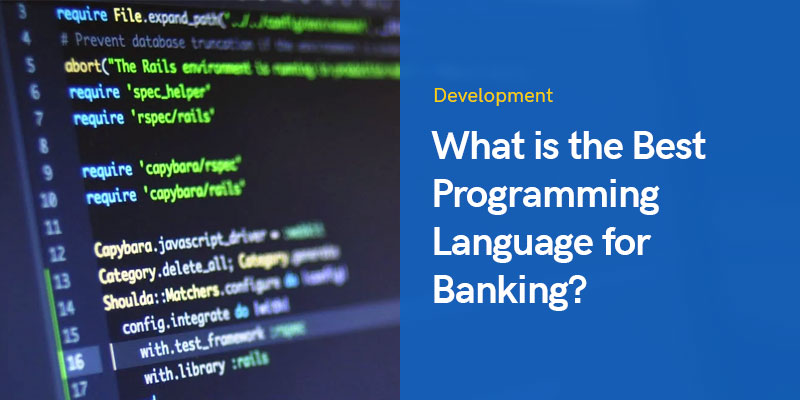
What is the Best Programming Language for Banking?
Fintech is a more relevant industry today than it was twenty years ago, and this trend is set to continue. There’s research to back this up, as investors now pour more than $50 billion into fintech companies per year. They have good reason to do so – around two-thirds of all financial transactions now happen online and 500 new fintechs come on board every year.
The immense potential of the new wave is not lost on banks. They stand a chance to earn up to 30 percent profit from operations alone, and the future looks good with more than 2 billion humans still unbanked. As banks mull how to stop the startups charging at them with tools of technology, they must devise ways to beat the latter at their own game.
Building the banking website or apps that backs customer goals might well begin with choosing the right tech stack. Programming languages are one critical facet of preferable tech stacks for fintech and banking.
This article reviews programming languages in banking and which banks would rather use.
Features of Programming Languages Suitable For Banking
The heavy lifting in banking applications happens on the backend. The language choices for backend applications keeps growing as even traditionally frontend languages such as JavaScript are staking a legitimate claim to the backend.
Typical backend languages include Golang, Java, PHP, Python, and Ruby. What a development team chooses to use usually depends on three variables:
- the scope of the project
- the need to deal with legacy infrastructure; and
- performance
Other important elements for choosing a backend programming language for banking include:
- Scalability
- Robust infrastructure
- Rapid handling of arising regulatory issues
- Rapid resolution of customer-facing issues
Reviewing Programming Language Options For Banking Applications
C++
The old warhorse has provided the building blocks for applications in astronomy, finance, manufacturing, medical science, and much more. C++ has proven its mettle as a preferred language for developing data-intensive solutions for quantitative financial analytics. Because it’s “close to the metal” as geeky types prefer to say, C++ is a fast and efficient language.
C++ offers high execution speed and can deal with numerous operations at the same time.
C++ developers emphasize “code reusability,” speeding up the process of repurposing code in later development stages.
There are many frameworks and tools available to C++ developers, and specialists in the language are abundant.
Despite the glowing plaudits, C++ is not as secure as some other languages making it a self-inflicted landmine with respect to regulatory compliance. The language is relatively complex, requiring newbies and recruits to spend plenty of time in it to master its nuances.
Java
Many software engineers still use Java as their primary software development language. It means there’s a vast pool of amazing talent to engage when building a personal or investment banking application, for instance. One upside of having many people write code well in a specific language is that it lowers the cost of hiring excellent developers.
Besides, you can get seasoned engineers with experience in a trusted tech stack for a great price.
Java is excellent for legacy projects where the backend is completely written in Java. Many banking applications have their roots in Java, so it’s easy to dive into the code to maintain anything once your team knows Java.
With a backend that holds plenty of sensitive data, banks need reassurance that their technology stack will hold up when bad actors strike [as they certainly will]. The robust structure of Java makes it probably the best programming language for banking, enterprise financial institutions, and emerging fintech startups. Java’s built-in security features include an advanced security manager and runtime constraints, effectively cordoning off cybercrime and fraud.
Developers can create products using Java’s massive library of tools and integrations. The sheer power of the Java Runtime Environment (JRE) and Java Development Kit (JDK) deliver excellent functionality and deliverability, critical components of finance and fintech.
Even as a mature programming language, Java is still lightweight and flexible while being powerful enough to handle massive amounts of data. Your customers can use Java on the device or operating system of their choice because of its Write Once, Run Anywhere principle. This is an excellent opportunity to provide competitive personalized offerings to clients and customers.
Kotlin
Kotlin is a relatively new technology which Google has classified as a “first class language” for its Android platform. Many fintech projects swear by Kotlin, partly because its design is based on a mobile-first approach.
Kotlin is a sweet spot for banking applications where security and quality are priorities.
Why would any bank use Kotlin to build their applications instead of more established programming languages? It is for reasons such as its high performance guarantee. It’s also highly compatible with Java and offers a functional JVM version. Kotlin syntax is simple, and the language features a reliable concurrency model.
Even though Kotlin offers many tools, frameworks, resources, and APIs developers find useful for building banking applications, the language has not garnered the critical mass of developers that the Javas of this world may boast of.
Python
Python is a solid scripting language that is great for building lightweight web applications. Its simple and intuitive syntax has won the hearts of many developers. The simplicity of Python’s syntax can be deceptive; the language is every bit comprehensive and continues to improve.
Python favors dynamic typing, meaning there is no need to explicitly tell the interpreter that “2” is a number or “debit” is a word, for instance. It can figure that out based on the operations you involve either in.
Because Python syntax is simple, a banking app development team can quickly become productive in it and keep technology adoption costs to a minimum. The ability to read, understand, and manipulate complex code quickly is an asset in fintech. Python facilitates this, so your time to market delivery and change implementations in line with regulations can help keep the competition at bay.
Python maintains a vast ecosystem of libraries, so developers can build platforms and microservices from predefined elements, third-party APIs and frameworks. This keeps integrations simple and fast.
Conclusion
Banking systems are typically complex, with many moving parts. Stability is a fundamental requirement in financial applications. Therefore, it is important that programming languages have comprehensive support for as long as may be necessary.
Banks will increasingly need to make trade-offs between longevity and the constant flux of the tech industry. Until there’s a way out, banks will continue to leverage the excellence of Java and other languages like it to develop satisfied customers.
Recommended Posts

WordPress Version Control: A Comprehensive Guide in 2023
February 14, 2023


the information ablout Best Programming Language for Banking is so great! I very like it.